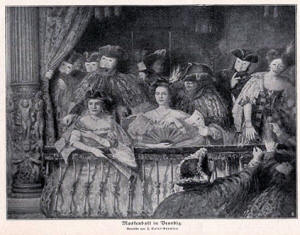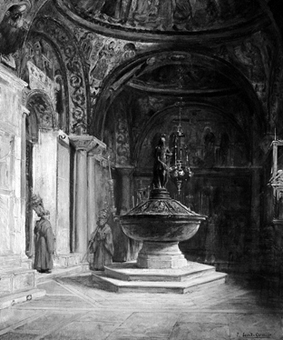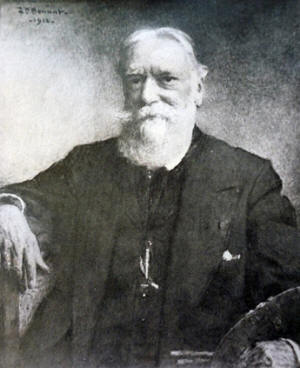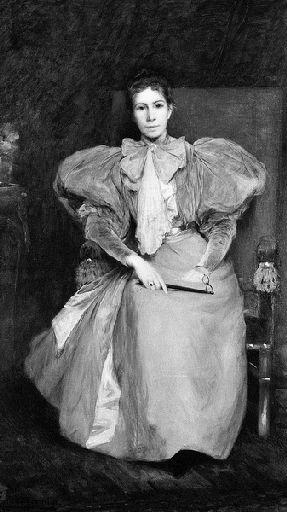::
BIOGRAPHIE
Joseph Saint-Germier
Artiste-peintre né à Toulouse
le 19 janvier 1860. Dans ses débuts, il aurait été élève du peintre
décorateur Pierre-Victor Galland (1822-1892) à Paris. Il a étudie à l'école
des Beaux-arts de Paris à l'atelier d'Alexandre Cabanel (1823-1889) puis, à
la mort de celui-ci, à l'atelier de Léon Bonnat (1833-1922).
En 1888, il
participa pour la première fois au Salon de Paris avec le tableau « La
navaja » (collection musée Bonnat-Helleu à Bayonne), tableau avec lequel il
obtient une mention honorable. Cette œuvre fut achetée par l’État en 1889.
Cette même année, le 14 juin, le Conseil Supérieur des Beaux-arts lui
attribue une bourse de voyage. C'est grâce à ce prix que l'artiste se rend
en Italie, en Espagne et au Maroc.
En 1891, il
expose au Salon annuel de Berlin « Une loge au bal masqué de Venise ». Ce
tableau, apprécié par le public, est reproduit et commercialisé en Allemagne
à travers des gravures sur bois, portant le titre de « Maskenball in Venedig ».
Quelques années plus tard, l’œuvre est présentée au Salon des Artistes
français de 1911 et acquiert une certaine popularité, renforcée par les
reproductions vendues en Angleterre sous le titre de « At the Masquerade ».
En 1998, la maison Sotheby's mit en vente ce tableau, sous le titre de « The masked ball », estimé à 15000 USD.

Saint-Germier, Joseph. Maskenball in Venedig (Une loge au bal masqué de Venise). Reproduction photomécanique d'une gravure d'époque d'après le tableau.
En 1896, Joseph
Saint-Germier reçoit les insignes de Chevalier de la Légion de Honneur. À
cette époque, il fixe son domicile au 11, square de Messine à Paris.
L'année 1897
est marquée par sa participation au Salon de la Société des Artistes
français avec « Une confrérie dans le baptistère de Saint-Marc à Venise »,
œuvre achetée la même année par la Société des Amis des Arts de Bordeaux,
actuellement en dépôt dans le musée des Beaux-arts de cette ville. Lors de
ce Salon, la peinture de Saint-Germier fut reconnue par le critique d'art de
la revue des Deux-mondes, G. Lafenestre, pour qui le peintre faisait partie
des jeunes artistes à l'avenir prometteur, méritant de se fixer dans la
mémoire de l'histoire de l'art.
Quatre ans plus
tard en 1900, il obtint une médaille d'or à l'exposition universelle de
Paris avec le tableau « Un enterrement à Venise », acquis par l’État en
1899, et actuellement en dépôt au musée d'Orsay.
En 1902, Saint-Germier
devint membre du comité d'honneur de la Société des amis des arts de
Bayonne-Biarritz dont le président était Léon Bonnat.
Il a notamment
eut une amitié forte et durable avec Bonnat. Entre mai et juin 1918, ils ont
exposé ensemble au Palais des Beaux-arts de Paris (Petit palais des
Champs-Élysées) au profit des œuvres de guerre de la Société des Artistes
français et de la Société nationale des Beaux-arts. On retrouve dans cette
exposition des œuvres des artistes tels que Carolus Duran (1837-1917), Puvis
de Chavannes (1826-1898), Auguste Rodin (1840-1917), Edgard Degas
(1834-1917). Pour cette exposition, dont le président de la commission était
Jean-Paul Laurens (1838-1921), Léon Bonnat exposa trois portraits parmi
lesquels celui de « Monsieur Joseph Saint-Germier » (localisation inconnue),
portant le numéro 60 du catalogue. Saint-Germier exposa également trois
œuvres : « Scène d’intérieur », « Masques à Venise » et « Un petit canal
vénitien ».
À cette époque, le peintre fixe domicile au 149, boulevard
Bineaud à Neuily-sur-Seine.
Témoin des profonds changements de la
peinture de son temps, l'artiste expose ses tableaux régulièrement au Salon
des artistes français. Il côtoie de près les grands intellectuels et
artistes de la Troisième république. À Paris notamment, il fréquente les
ateliers d'Albert-Pierre Dawant (1852-1923), Henri-Joseph Harpignies
(1819-1916) et du bordelais Alexandre-Gaston Guignard (1848-1922). En
Aquitaine, il visite l'atelier du peintre et graveur Max Bugnicourt
(1868-1936) à Bordeaux, puis celui du peintre Chilien Santiago Arcos y
Megalde (1865-1912), domicilié à Saint-Jean de Luz.
À une époque où
les styles et écoles foisonnent, Joseph Saint-Germier se révèle à la fois
peintre académique de genre et paysagiste. Au fil des années, il évolue vers
des thèmes divers, vues générales, sites célèbres ou scènes intimes, thèmes
où l'accent reste toujours de mise sur la matière picturale et la lumière.
Tout au long de sa vie, la base de son œuvre repose sur le dessin. De même
que le peintre Éloi-Noël Béraud (1875-1912), Saint-Germier est surtout connu
pour les vues qu'il peignait de la Cité des Doges. En effet, la lumière
particulière de Venise, les reflets d'eau dans les canaux, les nuances des
façades des bâtiments attiraient son regard et l'inspiraient pour reprendre
la grande tradition des vues panoramiques avec le souci d'en capter la
dimension atmosphérique.

Saint-Germier, Joseph. Le baptistère de Saint-Marc, 1894, huile sur toile. Collection du Musée des Beaux-arts de Pau. Photographie de Jean Christophe Poumeyrol ©
Ses nombreux
tableaux vénitiens font aujourd'hui la renommée du peintre. Avec ses vues du
Maghreb, il est également considéré parmi la pléiade des artistes dits
orientalistes.
Mais son
attirance envers des sujets locaux peut aussi l'inscrire dans la liste des
peintres régionaux ayant peint des paysages et des mœurs locaux d'une
Aquitaine pittoresque qui le marque profondément. Le tableau « Partie de pasaka au trinquet de Saint-Jean de Luz » en est un bon exemple.
Marié à madame
Mathilde Ludovica Reuter, épouse Saint-Germier, le peintre a deux enfants :
Philippe (1895-1925) et Antoine (1898-1975).
C'est à
Bayonne, le 5 juin 1925, que le peintre décède en laissant une nombreuse et
importante production.
Méconnu du
grand public faute d'expositions et de bibliographie, la figure et l’œuvre
de Joseph Saint-Germier demeurent à redécouvrir. Raillé par les avant-gardes
du XXe siècle et partiellement oubliées des historiens de l'art, ses
peintures se trouvent dans nombre de galeries, musées publics et collections
privées, en France et à l'étranger.
:: BIOGRAPHY
Joseph Saint-Germier
French
painter born in Toulouse on the 19th of January 1860. He was first a student
of the painter and decorator Pierre-Victor Galland ( 1822-1892) whom he met
in Paris. He studied at the École des Beaux-Arts in Paris. He was first
admitted in the in the studio of Alexandre Cabanel (1823-1889) until the
death of the latter, and later in the studio of Léon Bonnat (1833-1922).
He showed for
the first time in the 1888 Paris Salon where he exhibited his painting “La
navaja” ( now in the collection of the Musée Bonnat-Helleu in Bayonne) and
received the “mention honorable”. This work was bought by the French State
in 1889. On the 14th June 1889 he received a bursary from the Higher Council
of the Fine-arts to travel to Italy, Spain and Morocco.
In 1891, he
exhibited at the annual Salon of Berlin “Une loge au bal masqué de Venise”.
This painting was well received by the public. It was reproduced and
commercialised in Germany through wood engravings under the title of “Maskenball
in Venedig”. In 1911, the work was shown at the Salon des Artistes Français
and received some popularity which was reinforced by the reproductions sold
in Great Britain under the title of “At the Masquerade”. In 1998, Sotheby's
put up this work for sale under the title of “The masked ball” with a
selling estimate of US$ 10,000 / 15,000.
In 1896, he was made
Chevalier de la Légion d'Honneur. He then lived at 11 Square de Messine in
Paris.
In 1897 he showed at the Salon de la Société des Artistes
Français the work “Une confrérie dans le baptistère de Saint-Marc à Venise” which was purchased one year later by the Société des Amis des Arts in
Bordeaux, and is today stored in the musée des Beaux-arts of this city. This
painting by Saint-Germier was well revewed by G. Lafenestre, art critic at
the Revue des deux Mondes He noted that Saint-Germier was a painter whot
belonged to the young artists with a promising future and that he deserved
to be remembered in the history of art.
In 1900, he won a gold medal
at the Exposition Universelle in Paris with his painting “un enterrement à
Venise” which was purchased by the state in 1899 and is today in the store
of the Musée d'Orsay.
In 1902, Saint-Germier became a member of the “comité d'honneur de la Société des Amis des Arts” in Bayonne-Biarritz under the presidency of Léon Bonnat.

Bonnat, Léon. Portrait of Mr. Joseph Saint-Germier, 1918, oil on canvas. Location unknown.
He had a long
and close friendship with Bonnat. Between May and June 1918, they exhibited
at the Palais des Beaux-arts in Paris for the benefit of the war charity of
the Société des Artistes Français and the Société Nationale des Beaux-arts.
Also exhibiting in this show were artists such as Carolus Duran (1837-1917),
Puvis de Chavannes (1826-1898), Auguste Renoir (1840-1917), Edgard Degas
(1834-1917). The president of this exhibition committee was Jean-Paul
Laurens (1838-1921). Léon Bonnat exhibited three portraits, and among them,
the one of “Monsieur Joseph Saint-Germier” (location unknown), number
60 in the catalogue. Saint-Germier also exhibited three works: “Scène
d'intérieur”, “Masques à Venise” and “Un petit canal vénitien”.
At this
time, the painter lived at 149 Boulevard Bineaud in Neuilly-sur-Seine close
to Paris.
He continued to show his works at the Salon des Artistes
Français He remained in close contact with the great intellectuals and
artists of the Third French Republic. In Paris, He visited the studios of
Albert-Pierre Dawant (1852-1923), Henri-Joseph Harpignies (1819-1916), and
the native of Bordeaux Alexandre-Gaston Guignard ( 1848-1922). In Aquitaine,
he visited the studio of the painter and engraver Max Bugnicourt (1868-1936)
in Bordeaux and the studio of the Chilean painter Santiago Arcos y Megalde
(1865-1912) in Saint-Jean de Luz.
In a time where the styles and
schools abounded, Joseph Saint-Germier proved to be an academic genre
painter as well as a landscapist. Over the years, he evolved towards diverse
themes, panoramic views, famous places or intimate scenes where the accent
focused on the pictorial matter and the light. Throughout the course of his
life, his work was based on his drawing. In the same way as the painter
Éloi-Noël Béraud (1875-1912), Saint-Germier is especially known for his
views of the City of the Doges. Indeed, the unique light of Venice, the
water reflection in the canals, the nuances of the buildings' façades caught
his eye and inspired him to use the great tradition of the panoramic views
with the concern to capture the mood and the atmosphere.
His many Venetian paintings
are his claim to fame and he is also held in high regard by the group of
artists called the Orientalists for his views of the Maghreb.
Saint-Germier
painted the landscapes and the local mores of a picturesque Aquitaine that
left a deep mark on him. The painting “Partie de pasaka au trinquet de
Saint-Jean de Luz” would be a good example.He is therefore also known as a
regional artist.
Saint-Germier married Mathilde Ludovica Reuter, they
had two children: Philippe (1895-1925) and Antoine (1898-1975).

Saint-Germier, Joseph. Portrait of Mrs. Saint-Germier, 1894, oil on canvas. Collection of Musée des Beaux-arts de Pau. Photography of Jean Christophe Poumeyrol ©
On the 5th June
1925 joseph Saint-Germier died at Bayonne leaving behind an abundant and
important production.
Not well known from the general public due to the lack of exhibitions and bibliographies, the figure and the work of Joseph Saint-Germier remain to be rediscovered. Ridiculed by the Avant-gardists of the 20th century and partially forgotten by the art historians, his paintings are located in numerous galleries, public museums and private collections in France and abroad.